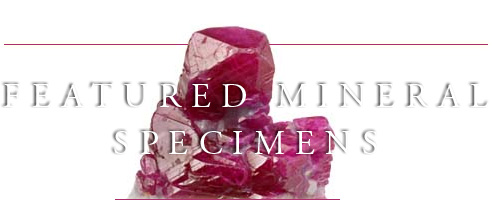
2011
Featured in Pala’s bi-monthly Mineral News. All photographs by John McLean unless otherwise noted. Newer specimens from 2012 and later are here.
December: Macedonian Ruby and Namibian Aquamarine
This month we feature a couple of new specimens acquired at the recent Munich.
The first is a massive ruby from Macedonia with defined crystal structure and an intense pinkish red hue. Pala bought a small selection of these stunning rubies, this one being the finest and largest of the group. This 425-gram hunk of ruby consists of two main crystals and multiple secondary clusters.
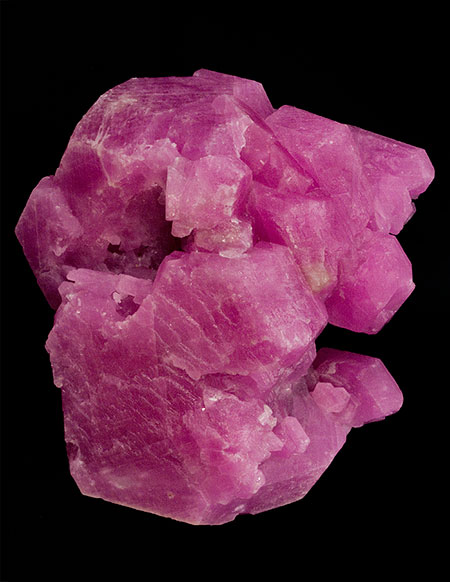 |
| Macedonian Ruby, 7 x 6.5 x 5 cm. Price available upon request. This specimen has been sold. (Photo: Mia Dixon) |
Another fun and large specimen unearthed at the show was this aquamarine and white-capped quartz from Erongo, Namibia. Several terminated aquamarines seem to dive into and leap out of the quartz host. Not a pristine specimen, but kind of a dirty, manly rock. For those collectors who like their specimens a little raw and rugged.
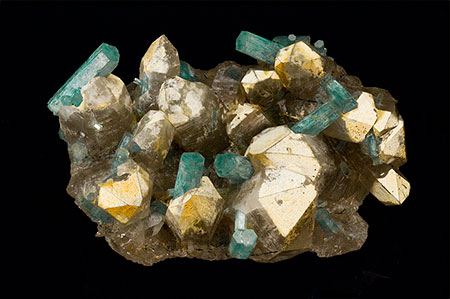 |
| Namibian Aquamarine, 13 x 8 x 7 cm. Price available upon request. Click to enlarge. (Photo: Mia Dixon) |
Interested? Call or email us to inquire. [back to top]
October: Alexandrite from Zimbabwe
This month we feature a phenomenal specimen from the Girdlestone claim in central Zimbabwe.
This is an exceptional alexandrite sixling with well defined arms and multiple crystalline structures running throughout the specimen. The most impressive aspect of the piece is the drastic color change from an emerald green in daylight to a reddish-purple in incandescent light. This is a color change comparable to the great faceted Russian alexandrites we all hear about but never get to see in person because mining is long gone, and the few such stones are hidden deep in old collections.
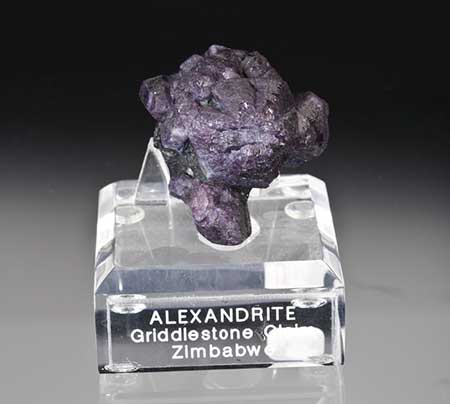 |
| Color change alexandrite from Zimbabwe, 4.2 x 4.1 x 2.9 cm, from the Girdlestone Farm locality in the southeastern province of Masvingo. Above: Reddish purple in incandescent light. Below: Emerald green in daylight. Colors are captured in ideal lighting; in low, mixed light the specimen takes on a much darker appearance. Price available upon request. (Photo: Jason Stephenson) |
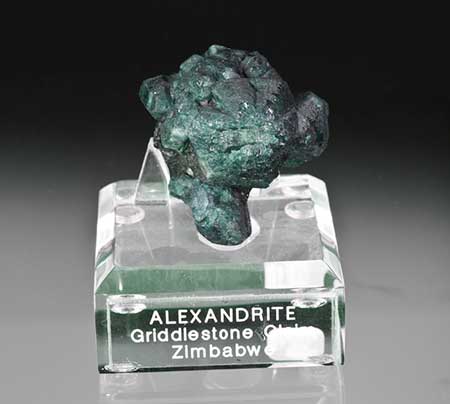 |
This is a great opportunity to capture a truly unique and phenomenal specimen. Zimbabwe alexandrite combines exceptional color change along with well formed crystals.
Interested? Call or email us to inquire. [back to top]
August: Aquamarine from Namibia
This month we feature a complex and stunning aquamarine specimen from the Erongo Mountains in Namibia. This wonderful find was first discovered about two year ago. Many specimens are comprised of this outstanding mix of blue aqua, black schorl and white feldspar. This dramatic combination is very appealing and diagnostic of the Erongo region. When you see a fantastic specimen like this one, you will know exactly where it’s from.
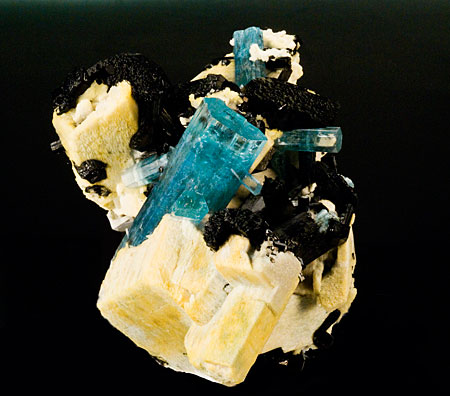 |
| Aquamarine, schorl and feldspar from Namibia, 14 x 11 x 8 cm. Price available upon request. Click to enlarge. (Photo: Mia Dixon) |
Some time ago, Pala bought a large parcel of these black, white and blue specimens from thumbnails to cabinet size. Now it seems we have saved the best for last with this particular monster. Pala recently obtained this piece, which was held back for a while in a private collection in Idar-Oberstein.
See our selection of aquamarine here. Many other pieces that have not been posted are available.
Interested? Call or email us to inquire. [back to top]
June: Black Spinel and Golden Topaz from Burma
This month we feature a couple of new jewels from Bill and Will Larson’s trip to Bangkok and Burma: a black spinel from Pein Pyit and a golden topaz from Sakangyi, both localities in Mogok.
The spinel is a completely unique specimen, drawing these words from Bill, who has had 30-plus trips to Burma: “I have never seen anything like it.” In most lighting, the piece is a jet-black spinel embedded in pure white calcite, which makes for a very dramatic specimen. With transmitted light the spinel has an intense reddish-purple hue. The crystal exhibits the classic octahedral shape, with rounded edges and smooth, glassy faces.
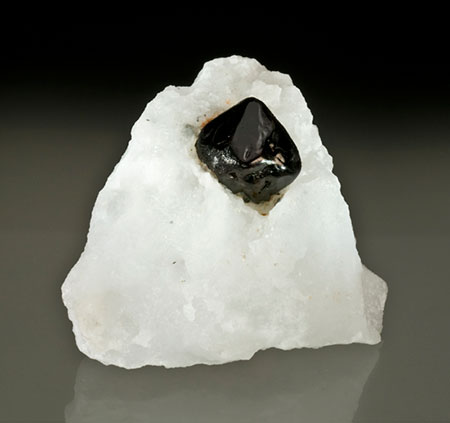 |
| The Prince’s Black Spinel. Specimen 7.3 x 8 x 5.5 cm.; crystal 2.5 x 2 mm. (Photos: Jason Stephenson) |
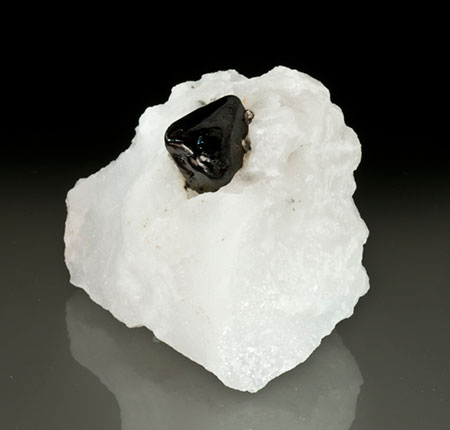 |
The topaz is a spectacular gem sure to impress veteran and novice collectors alike. The color shifts from peach to cognac as you fumble it around in your hands. You even pick up some interference-colors flashing off of the internal features. It has a beautifully symmetrical crystal form with sharp edges and glassy faces. There is some damage on the bottom, but it hardly takes away from the impressive feel of the crystal.
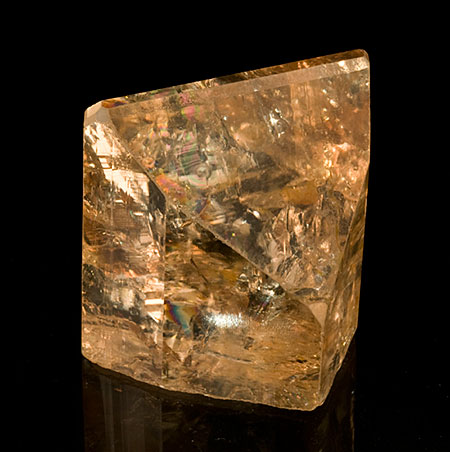 |
| Golden topaz, 8.5 x 7 x 6.2 cm. (Photos: Jason Stephenson) |
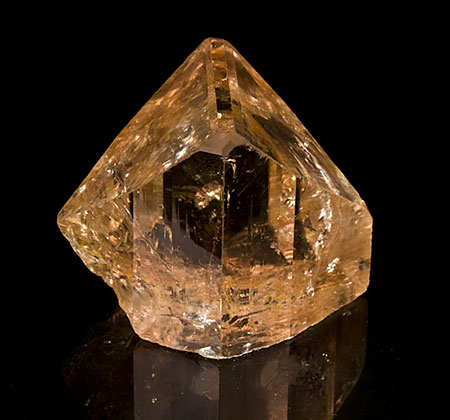 |
For more on topaz, see below.
Interested? Call or email us to inquire. [back to top]
April: Foreign and Domestic
This month we feature a couple of items that are new to the Pala catalog.
First up is an amazing copper in calcite from the Keweenaw Peninsula in Michigan. It has a beautiful scalehedron structure, a massive white calcite in the core and a clear outer layer including the peak of the crystal, which is transparent. The center layer is a brilliant copper phantom that scintillates in the light.
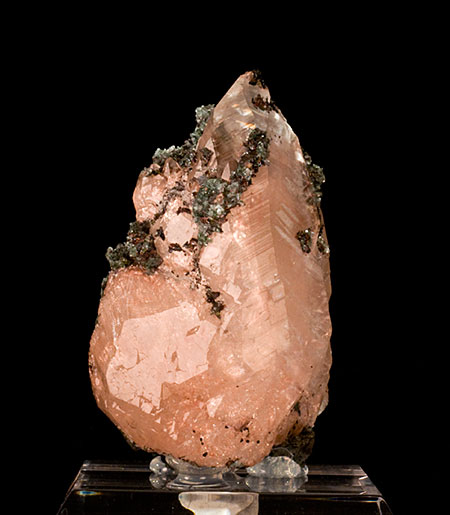 |
| Copper in calcite, Keweenaw Peninsula, Michigan, 8.0 x 5.5 x 4.5 cm. Price available upon request. (Photo: Jason Stephenson) |
With impressive size, shape and color this specimen is definitely an icon in the mineral world. No damage, no repairs, just a pristine beauty.
This specimen was collected by Ben Williams’s father, John Williams, in the 1860s. During this time period the elder Williams worked at the copper smelter in Hancock, Michigan. Ben would have been a young teenager at the time. These pieces were likely passed on from father to son and pre-date Ben’s arrival at Bisbee, Arizona by about 15 years.
Most of these copper-in-calcites came out in the 1800s and early 1900s. The two main mines that produced this rare blend were the Quincy Mine and the Franklin Mine around Hancock, Houghton Co., in Michigan.
See more on Keweenaw Copper District in the current edition of Rocks & Minerals (courtesy of last year’s Rochester Mineralogical Symposium).
This month we also must mention a superb tanzanite crystal from Merelani in Tanzania.
 |
| Tanzanite from Merelani, 39 grams, 4.7 x 2.5 x 1.8 cm. Inventory #19089. |
This is an exquisite prismatic crystal with perfect form and—like our other featured specimen—in pristine condition. All the crystal faces are well defined and lustrous, encasing a seemingly flawless crystal. Its completely natural color includes strong trichroism of blue and purple, along with red seen down the c-axis. Most of the inside is very gemmy and could literally be fashioned into a large faceted stone.
The desire for fine tanzanite crystal specimens has finally made its way into the minds of the miners. More care is now being taken to pull them out of the ground in order to preserve them in the rough. Part of this shift in thinking may be due to the softening of the faceted tanzanite market. Calls for cut stones are on the decline while crystal hunters are now on the prowl. Luckily we on the mineral collector end are thus seeing a wider selection of material and some of the finest tanzanite crystals to be unearthed.
Pala purchased a small but choice selection of fine crystals earlier this year. Click here to see our new tanzanite specimens.
Interested? Call, select the inventory number above, or email us to inquire. [back to top]
February: Kunzite from California
Pala District reveals more hidden gems… Just in time for the California Minerals theme of this year’s TGMS show
We have been reporting the colorful progress at the Oceanview Gem Mine for the past few years. The most recent find has unearthed some spectacular kunzites. The area is well known for kunzite, dating back to 1903 when Dr. George Frederick Kunz first identified this new gem material from some samples taken from the White Queen Mine. (See “On Kunz and Kunzite” by Lawrence H. Conklin for the full story.)
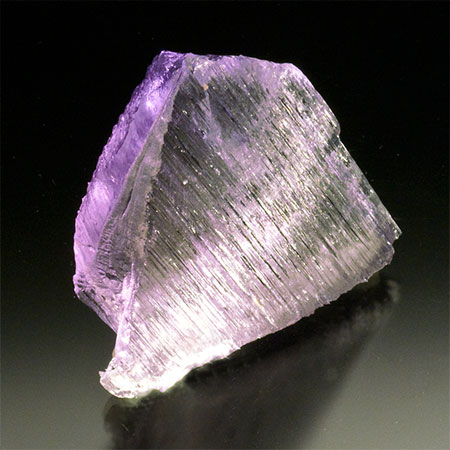 |
| Oceanview Kunzite, 6.7 x 5.8 x 1 cm. Price available upon request. Above, showing the width of the blade, and below, showing the deep lilac color down the C axis. (Photo: Jason Stephenson) |
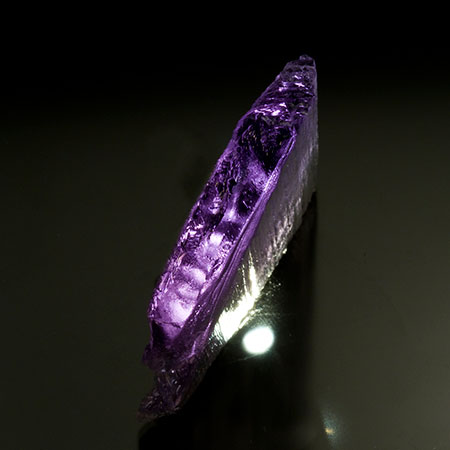 |
This month we feature an exceptional kunzite from the find in December 2010. Kunzites range from fine miniatures to potentially some of the largest ever found in San Diego County. Beautiful colors abound, including deep purples and blue greens, and some crystals are even bi-colored. We are proud to offer you some of the first specimens from Jeff Swanger and his hardworking crew up at the Oceanview Mine. Stay tuned to see the variety of material coming out of this most recent find.
Interested? Call or email us to inquire.
Visit us at the Westward Look and Tucson Gem and Mineral Show, at which we will have many kunzites directly from the mine.
See also
- “Pala District Pegmatite Opens Wide” on Palaminerals.com
- “Pala District Pegmatite Opens Wider” on Palaminerals.com
[back to top]
2010
Featured in Pala’s bi-monthly Mineral News. All photographs by John McLean unless otherwise noted.
December: Peruvian Fluorite and Austrian Epidote
This month we feature a lavender fluorite from Peru and an epidote from Austria.
This is a peculiar fluorite crystal composed of interlocking beveled cubes. It’s almost surreal to fumble this miniature mineralscape around in your hands. This is a true work of art from Mother Nature: a floater, almost complete all the way around, with only a few contact points. There are a couple of trace pyrite crystals on the back side. The specimen was found at the Huanzala Mine in Peru, which is known for fine specimens of fluorite and pyrite while production of lead and zinc can reach up to 1200 tons per day.
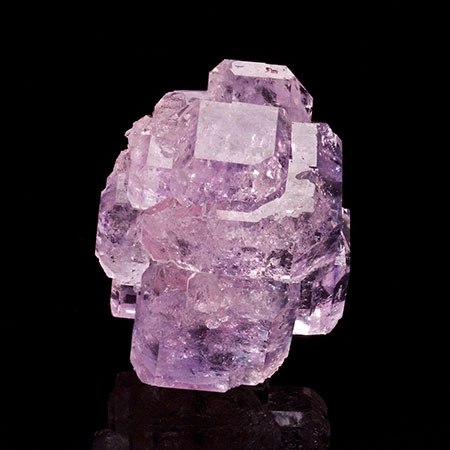 |
| Lavender fluorite. This fluorite (click to enlarge) comes from the Huánuco Department of central Peru. Dimensions: 5.4 x 4.7 x 4.2 cm. Inventory #18830. (Photo: Mia Dixon) |
The epidote comes to us from the historic Knappenwand Mine in Austria, on which we reported recently.
Large fine epidotes are extremely rare from this locality, and the association of calcite and bissolite makes this piece one-of-a-kind. The geodesic-like calcite creates a solid foot for this long and complex epidote; then the sprinkling of bissolite adds to the character. The main epidote crystal is striated and well formed with a curvature at the top and many intersecting, smaller epidote clusters. There are some contact points on the back, but it is very complete from the front. A superb matrix specimen from a classic locality.
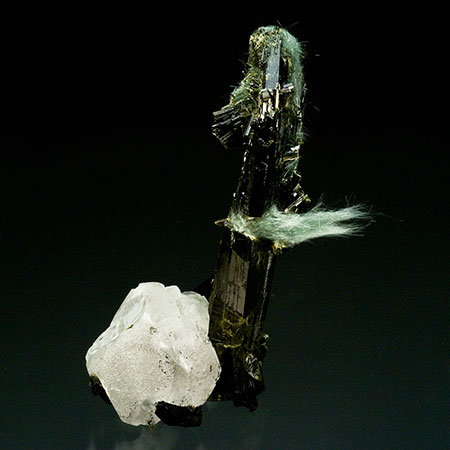 |
| Epidote. This epidote (click to enlarge) features delicate bissolite filaments. Dimensions: 12 x 6.2 x 5 cm. Price available upon request. (Photo: Mia Dixon) |
Interested? Call or email us to inquire. [back to top]
October: Pink Fluorite from Pakistan
This month we feature a fluorite full of beauty. At first you notice the subtle pastel pink hue and then the complexity of the crystal formation. It’s like a big scoop of strawberry ice cream topped with a little muscovite flower.
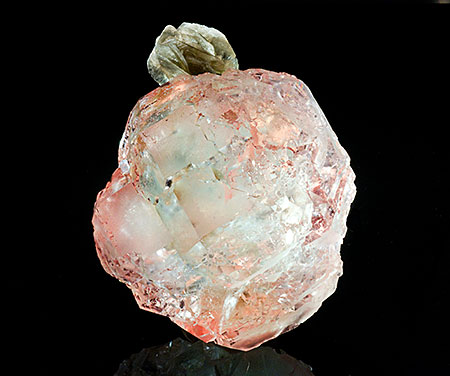 |
| Pink fluorite from Pakistan. This fluorite was found near Nagar, a small village in the Hunza Valley of Northern Pakistan. Dimensions: 10.5 x 8.5 x 6 cm. Price available upon request. (Photo: Mia Dixon) |
Frozen in time, this jewel glows with enticement and intrigue. It’s a mix of glassy and frosted faces covering a gemmy core that plays with the light and creates a unique impression. This is one of the many specimens acquired at last month’s Denver show.
Interested? Call or email us to inquire. [back to top]
August: Rhodochrosite from Peru, Phenakite from Burma
This month we feature two new specimens the Larsons picked up while at the Sainte-Marie-aux-Mines show last month: a rhodochrosite from Peru and a phenakite from Burma. (Bill Larson tells us that a report on the show is forthcoming…)
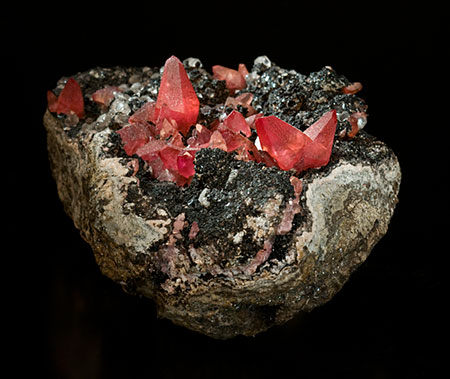 |
| Rhodochrosite from Peru. Price upon request. (Photo: Jason Stephenson) |
The rhodochrosite comes to us from the Uchucchacua Mine in the Oyon province, Lima Department in Peru. Clusters of intense orangey-red rhodochrosite scalenohedron crystals mixed with tiny fluorite crystals are scattered on a black gritty matrix. It features several pristine rhodochrosite crystals around 1 cm. in length and a twin perched right on the edge of the specimen.
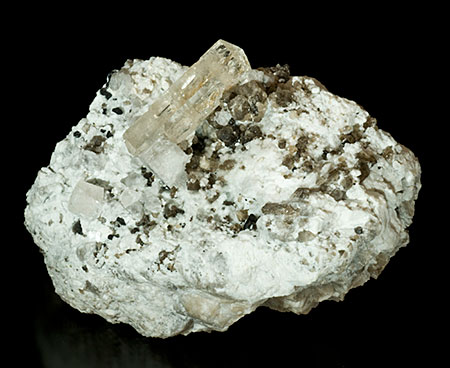 |
| Phenakite from Mogok, Burma. Price upon request. (Photo: Jason Stephenson) |
The phenakite come to us from Kat Chay Mine, Momeik, Mogok, Sagaing District, Mandalay Division, Burma. A doubly terminated phenakite crystal is positioned amongst a salt-and-pepper matrix of feldspar and quartz. The phenakite crystal is 3.7 x 1.2 x 1.0 cm. and very gemmy with a glassy drill bit termination.
Interested? Call or email us to inquire. [back to top]
June: Jonas Mine Tourmaline
This month we feature an icon in the mineral world: a tourmaline specimen from the famous Jonas Mine in Brazil. This large crystal is one of a small batch of rubellites that came out of a single pocket opened up in 1978, that produces some of the most intense purple/magenta rubellite the world has ever seen.
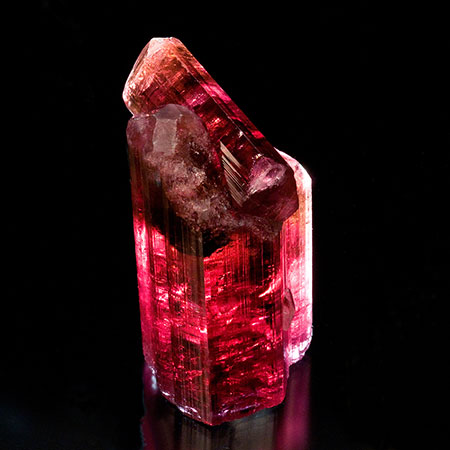 |
| Rubellite tourmaline specimen from the Jonas Mine in Minas Gerais, Brazil. Price available upon request. (Photos: Mia Dixon) |
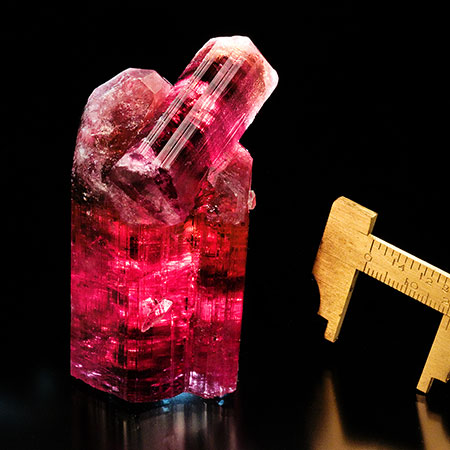 |
This rare specimen is exceptional because of the size and girth of the main crystal, measuring 6.6 x 3.8 x 3.8 cm., making it one of the thickest single crystals from the historic Jonas pocket. To top it off, this exquisite crystal has a penetrating twin perch right on top. This secondary crystal measures 4.9 x 1.8 x 1.7 cm., and adds key aesthetics to make this a world class specimen. Both crystals actually contain some hidden gem material that could potentially yield some large faceted stones (but, of course, that will be left up to the imagination).
This is a good opportunity for collectors to own a piece of geologic history.
Interested? Call or email us to inquire. [back to top]
April: Two Hybrids
This month we feature two new and fascinating specimens. An intriguing malachite and shattuckite from the Kaokoveld region of Namibia and a hübnerite and quartz from Pasto Bueno, Peru.
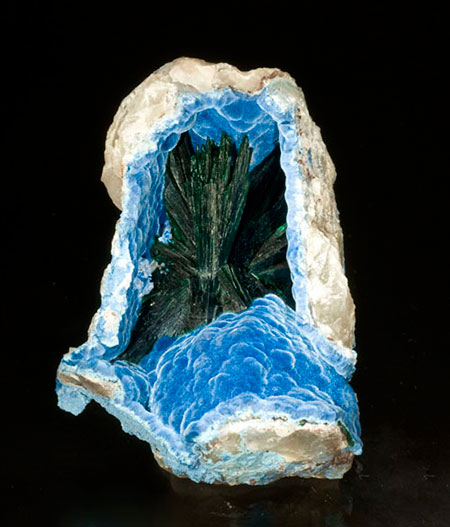 |
| Malachite in shattuckite from the Kaokoveld region of Namibia, 7.5 x 5.4 x 3.1 cm. Price upon request. (Photo: Jason Stephenson) |
Our first featured mineral is an amazing shattuckite vug with a acicular malachite spray. The shattuckite is in a blue velvety botryoidal form coating the inside of the little box-shaped vug. The malachite is a dark evergreen color with clusters of tiny needle-shaped crystals. Most crystals grow right into the walls of the pocket, but a few of them actually terminate at the top of the box, just kissing the shattuckite. A limited number of specimens of shattuckite and malachite have surfaced from the Kaokoveld region recently; the aesthetics and wonder that this piece holds go beyond all others of its kind.
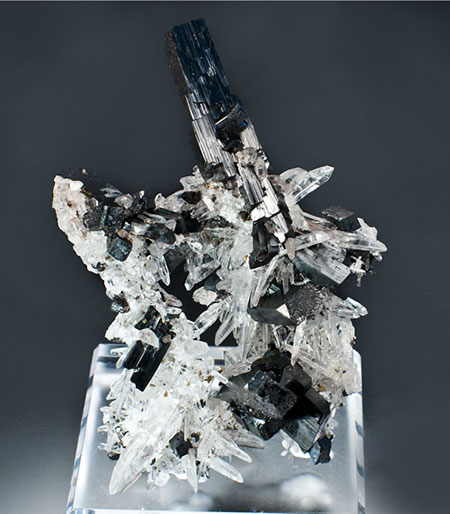 |
| Hübnerite and quartz from Pasto Bueno, Peru, 15.6 x 10.5 x 6 cm. Price upon request. (Photo: Mia Dixon) |
Our second feature is a dazzling display piece with a ring of jagged white quartz clusters contrasted by lustrous black hübnerite rods. Quartz crystals are slender and clear, ranging from a few millimeters to one 4 centimeters in length on the bottom left that is part of a Japan-law twin. The quartz is interwoven between the hübnerite, and actually penetrates in a few spots. The hübnerite crystals range from several millimeters to a complex 8-centimeter crystal that is perched atop the specimen. It’s a very chaotic and ornate arrangement that keeps drawing you in for a closer look. This magnificent specimen comes to us from Mundo Nuevo in the Pasto Bueno and Ancash Departments in Peru.
Interested? Call or email us to inquire. [back to top]
February: Burmese Red Spinel
This month we feature a Burmese red spinel with a single octahedral crystal, in conjunction with the theme of this year’s Tucson Gem and Mineral Show: gem crystals. As the world opens its eyes to new gem varieties, spinel is standing at the front of the line, intense and beautiful. Nothing better than a good ol’ fashioned flame-red spinel. This spinel exhibits the best Burma has to offer, with a slightly orangey red hue, high saturation, and a pleasing cushion cut.
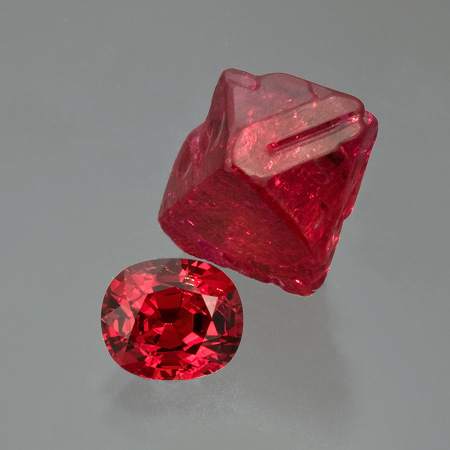 |
| Crystal & jewel: 2.24-carat Burmese faceted red spinel, 8.3 x 7 x 5.1 mm,, with 15-carat Burmese spinel crystal, 17 x 12 x 10.5 mm. Inventory #16655. (Photo: Mia Dixon) |
As we see many deposits producing fine spinels these days, with Tanzania, Tajikistan, Vietnam, Madagascar, and Sri Lanka, to name a few, nothing quite compares to some of the rich reds that are produced in Burma.
Interested? Select the inventory number above, call, or email us to inquire. [back to top]
2009
Featured in Pala’s bi-monthly Mineral News. All photographs by John McLean unless otherwise noted.
December: Epidote
This month we feature an intricate cluster of epidotes from Knappenwand and add a layer of interest by supplementing the beauty of morphology in a painting by Gamini Ratnavira.
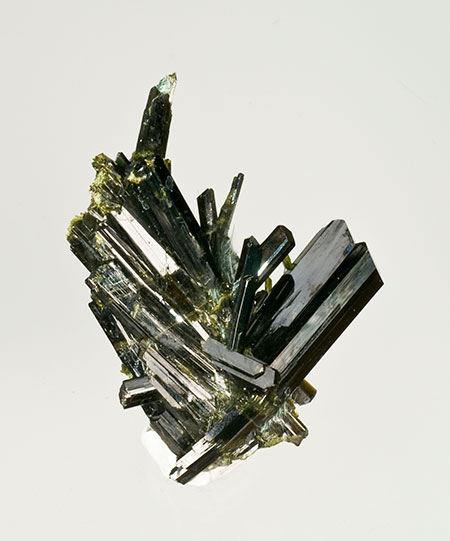 |
| Knappenwand epidote, 6.1 x 4.4 x 1.8 cm. Price available upon request. (Photo: Jason Stephenson) |
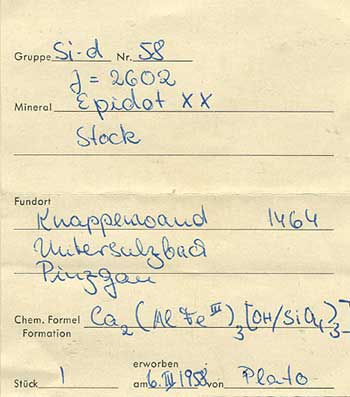 |
This pristine epidote embodies the essence of the great black crystals that have made the Knappenwand mine in central Austria such a famous locale. A 3-cm. crystal anchors this specimen on the right, and a beautiful fan illuminates the piece on the left. Slender jet-black crystals flower out of the center, terminating in lustrous black caps to the right and ending in fibrous green to the left.
For more information on this Austrian locality, see our previous epidote offering from June 2007. And visit our mineral search for a selection of epidotes from around the world.
Interested? Email us or give us a call (telephone numbers below). [back to top]
Artist Gamini Ratnavira is a Fallbrook neighbor to Pala International. While he is well known for his paintings of tropical wildlife, in mineral circles his renditions of mineral specimens are valued as well. Gamini’s work will be featured at the upcoming Westward Look Mineral Artists exhibition in February. The following biographical sketch will give insight regarding his craft.
Gamini Ratnavira was born and raised in tropical Sri Lanka. Gamini comes from many generations of fine jewelers, as Ratnavira means “hero of gems” and members of his caste were jewelers to the Kings and Queens of Sri Lanka. Gamini’s father, Sardha Ratnavira, was the first Asian to qualify at the Gemological Institute of America, in 1937–1938, when it was still in Los Angeles.
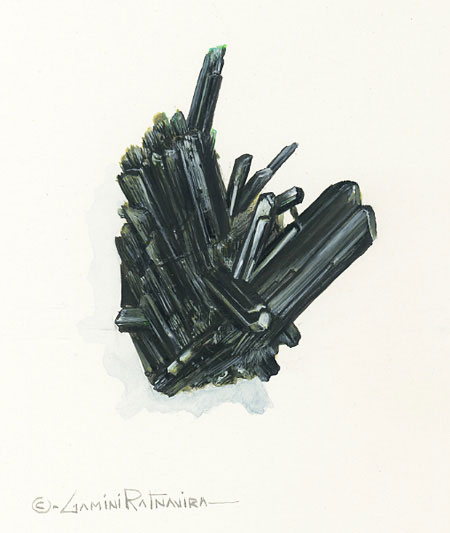 |
| Gamini’s painting accentuates the character of all the individual crystals of our featured specimen, capturing every little face and striation. A little masterpiece to accompany earth’s complex symmetry. (Illustration: Gamini Ratnavira) |
Growing up near the mines in Ratnapura (“city of gems”), Gamini developed an eye and appreciation for minerals and began painting tourmalines in the 1980s for a forthcoming book by Bill Larson. Additionally Gamini has painted dozens of originals for the renowned mineral dealer Dr. Rob Lavinsky and appears annually at the Tucson Gem and Mineral show.
As a self-taught artist Gamini uses his photographic memory and life experiences to produce vibrant, colorful images of the rain forest flora and fauna, which are complimented with intriguing stories and research information about each painting. His paintings reveal his love for art coupled with an unrestrained, lifelong reverence for nature. As a renowned wildlife artist who has traveled to over 40 countries, accumulating a bird list in the 4,000s, Gamini’s artwork continues to honor endangered species and represents a lifetime of honoring nature. Internationally collected, his artwork can be visited at his website and at his gallery on BlueCap Productions. [back to top]
October: Kearsarge Lode Silver
This month we feature a pleasant little silver from the Kearsarge Lode in Michigan. This is a crystaline specimen that seems to branch out like a tree, with roots and all. Very aesthetic cluster that would work well in any metals or USA collection.
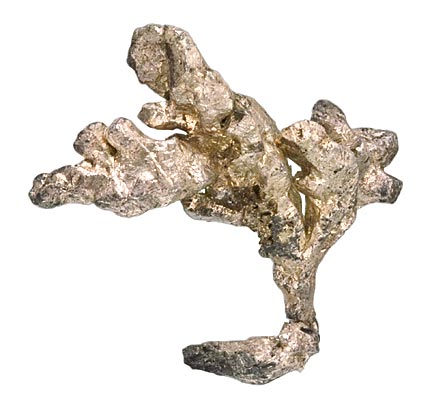 |
| Shake a tail feather. Silver shown at two different angles. Dimensions: 42 x 38 x 10 mm. Weight: 25.2 grams. There is an “odd” perspective in the photo below. Can you see the rooster? He’s waving at you. |
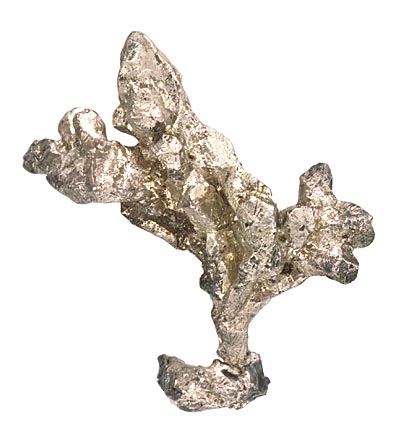 |
The Kearsarge Mine is in northwest Michigan, in the Keweenaw penninsula, and produced large amounts of copper starting in 1886. Peak production occurred between 1887 and 1897, in the form of 14.5 million pounds of refined copper. These mines also produced some of the best silver specimens in the Keweenaw region. The entire mine was eventually closed in 1956. More info from Mindat.
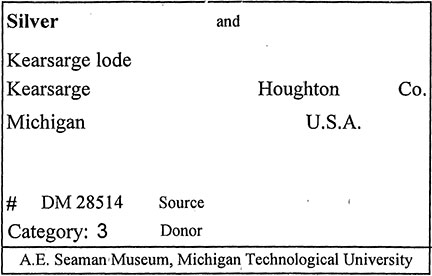 |
| Vintage label from the A. E. Seaman Mineral Museum at Michigan Tech. |
Interested? Email us or give us a call. [back to top]
August: English Calcite Cluster
This month we feature a delightful calcite cluster from the Bigrigg Mine in the Cumberland region of England. Calcites such as this one have been collected and revered in England dating back to the 1800s. Intricate clusters and transparent scalenohedral crystals have defined these calcites as world-class specimens. Since many of the mines around Cumbria have been closed since the 1950s, these stunning calcite clusters are highly desired amongst collectors, rarely appearing on the market. The piece is ex Francis Benjamin, the prestigious collector from Bordeaux.
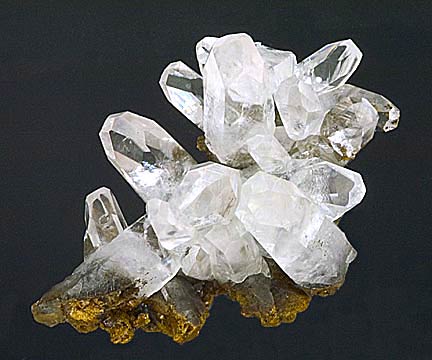 |
| Calcite cluster from the Bigrigg Mine, Cumberland, England, 4.9 x 9.6 x 5.8 cm. Inventory #17577. |
Here is your chance to grab a part of England’s historical calcite bounty. This is an exquisite cabinet specimen with randomly oriented individual crystals ranging from 3.5 to 1 cm. on a dark brown clay matrix.
Interested? Email us, select the inventory link above, or give us a call. [back to top]
June: Tanzanian Crystals
Merelani Hills offer a varied array of choices
The Merelani deposit in Tanzania has consistently produced a wide variety of gem crystals since its initial discovery in 1966. Along with the huge success of tanzanite in the gemstone industry, Merelani has opened up a spectacular array of intense gem crystals: lime green diopside, evergreen tremolite, mint green grossular garnet, and yellow to green zoisite crystals.
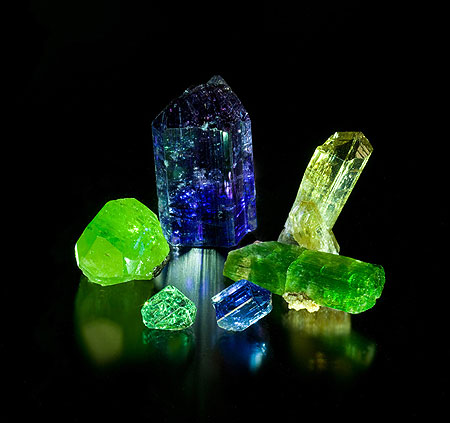 |
| Merelani mix. Clockwise from top center: tanzanite 5.5 x 2.7 cm., yellow zoisite 4.6 x 1.5 cm., tremolite 5.1 x 1.8 cm., tanzanite 1.7 x 1.1 cm., grossular garnet 0.9 x 1.4 cm, diopside 3 x 2.5 cm. From the collection of Bill Larson. (Photo: Jason Stephenson) |
As the love of tanzanite crystals has grown amongst individuals in the mineral community, their hands of desire have stretched by way of the mineral dealers, and have fostered in some miners an appreciation for pristine crystals that must be extracted with care. As higher prices have been paid for tanzanite, this crystal preservation mentality has spawned a steady stream of tanzanite crystals reaching the marketplace for all levels of collectors to enjoy. Fortunately for the connoisseur, out of this production we do see the occasional rare formation or matrix piece.
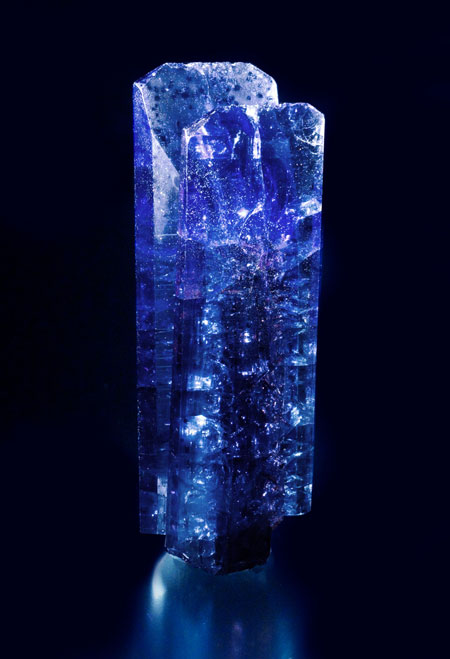 |
| Tanzanite crystal, 7.2 x 2.5 x 1.5 cm. The weight is 330 carats! Price available upon request. (Photo: Mia Dixon) |
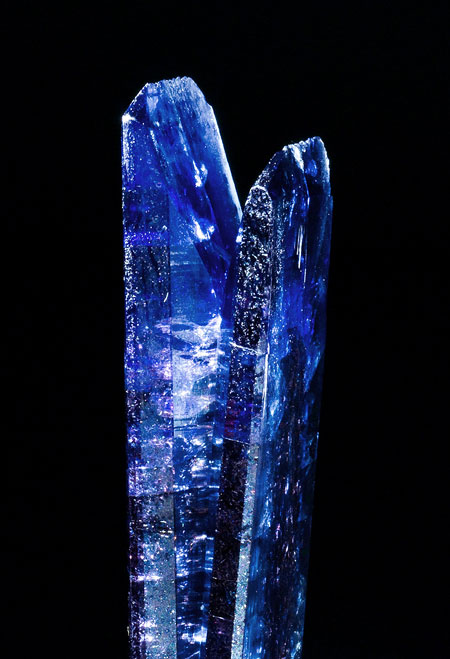 |
This month we show off a striking tanzanite crystal that seems to be in a contact twinned pattern. The inclusions create a starburst pattern with transmitted light, with a purple banded core and a blue perimeter. This delicate piece didn’t make it out unscathed, however; there is some minor damage and an excellent, clean repair.
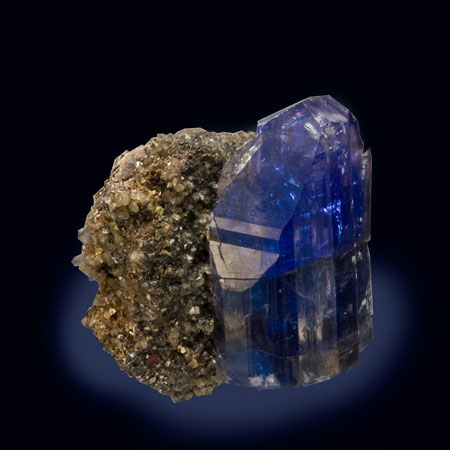 |
| Tanzanite crystal with matrix, 2.8 x 2.7 x 1.8 cm. Price: $2,000. Inventory #17398. |
The second tanzanite crystal surfaced with some matrix still attached, which is extremely rare because of the weak contact between the brittle graphite conglomerate and the glassy tanzanite surface. An exceptional miniature for those who collect matrix specimens.
Interested? Email us, or give us a call. [back to top]
April: Bigger Is Better
In the Heavyweight Division…
This month we though we’d whip out some big minerals for those who like some poundage for their buck. In this heavyweight mineral bout we feature a large, classic pink tourmaline from Afghanistan and a monster feldspar oddity from Madagascar. Pala’s Bill Larson acquired this historic piece, which dates back to the mid-20th century, at last year’s Munich show.
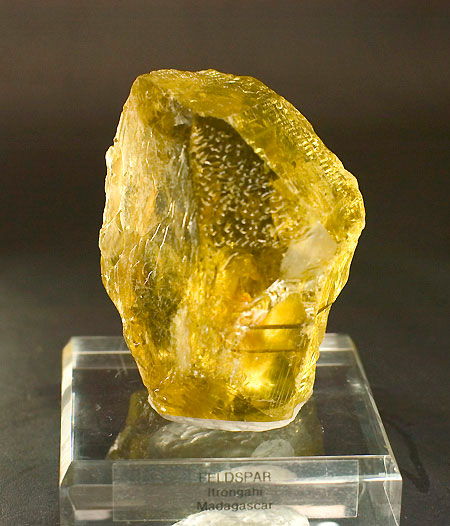 |
| Feldspar. Dimensions 4.5 x 3.5 x 2.25 inches. Price available upon request. (Photo: Jason Stephenson) |
In this corner, weighing in at 1.77 lbs., an outstanding orthoclase feldspar single crystal from Itrongahi (aka Itrongay), Madagascar.
This is arguably the largest gem orthoclase crystal on the planet. This behemoth not only exhibits some complete crystal faces, it also contains a large amount of gem-worthy portions. The intense, slightly greenish-yellow hue is very deceiving at first, as your first synapse calls out, “Heliodor.” But as the crystallography is illuminated, it’s clearly from the feldspar family.
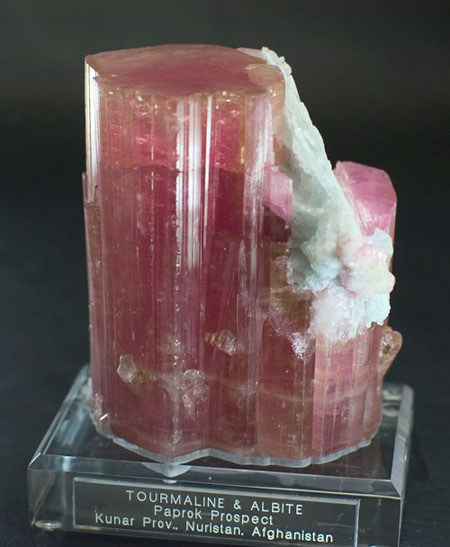 |
| Pink tourmaline. Dimensions 4.5 x 3.5 x 2.5 inches. Price available upon request. (Photo: Jason Stephenson) |
In this corner, weighing in at 2.82 lbs., our second feature is a massive pink tourmaline crystal with an albite plate splitting the main crystal from a smaller secondary termination.
Here we have a classic pink tourmaline from the Paprok prospect of northeastern Afghanistan; a striated shaft with small tourmaline crystals popping out all around. The specimen is capped by a thin green layer and a flat termination. It features a beautiful assortment of light and dark pink hues mixed with the white albite and a few greenish zones.
Interested? Email us, or give us a call. [back to top]
February: Romanian Calcite
Is this odd to you?
How odd does a mineral have to be to qualify as an oddity? This year’s Tucson mineral show, with its theme “Mineral Oddities,” will be the pool to dive into and ponder the shtick surrounding the word as it relates to the mineral world, and engage the sticklers who indulge in the unusual.
Minerals are the end-members—born out of a chaotic convergence of chemistry, heat, time, and pressure—representing the infinite possibilities of crystal formation. Every mineral specimen is unique and some leave a lasting, sometimes odd, impression. A recognizable form or personified rock can be a visual stimulant that skips the usual beat and requires a second look. An animal form, a miniature landscape, geometric shapes, and, of course, balls of all sizes and textures.
We though we’d show you a few calcite balls of our own—from Romania: coconut twin spheres and some prickly conjoined ones.
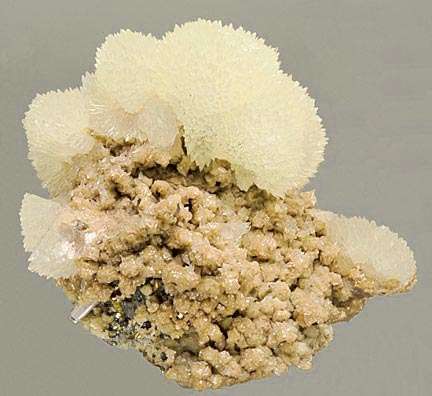 |
| Pack of porcupines? Dimensions 9 x 5.5 x 7 cm. |
These oddball calcite orbs come to us from Romania. The first one is from the Boldut mine in Cavnic, Romania. It’s an interesting assemblage of calcite clusters huddling together like a family of porcupines.
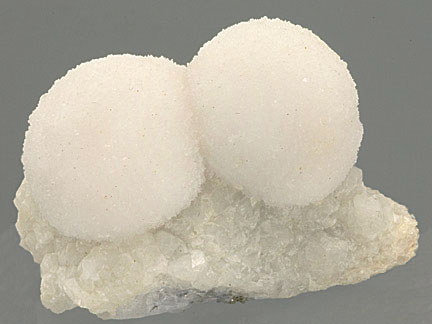 |
| A double-shelled snail? Dimensions 4.6 x 2.8 x 3.1 cm. |
The second specimen is from an undetermined locality in Romania and conjures up all sorts of strange associations.
Interested? Email us, or give us a call. Or see them for yourself—and the other oddities we’ve assembled—in Tucson. [back to top]
2008
Featured in Pala’s Mineral News. All photographs by John McLean unless otherwise noted.
December: A New Influx of Mineral Oddities from Namibia
When we hear the phrase “Namibian minerals” we think of all the great carbonates from Tsumeb, Erongo aquamarines and fluorites, amethyst from Brandberg—the list goes on and on. But out of all the holes dug in this vast country, we haven’t seen all the unusual treasures Namibia has to offer. For instance, in the last year or so we have seen some new twists on some old favorite species from the Erongo region.
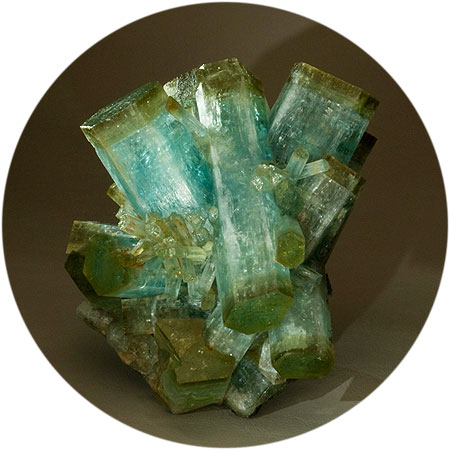 |
| Golden heliodor cap with a sharp contact next to the aquamarine shaft, 12.5 x 9.0 x 8.5 cm. Price available upon request. (Photo: Jason Stephenson) |
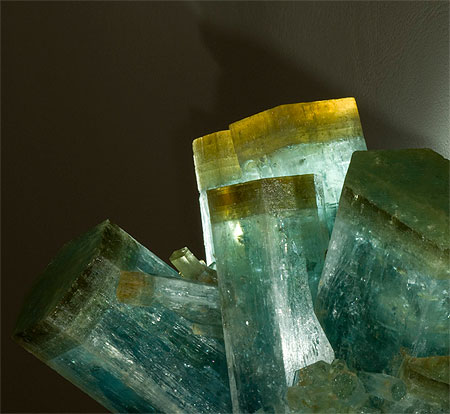 |
First we look at a heliodor-capped aquamarine cluster with big cigar-sized crystals. The center crystal is actually doubly terminated. Most faces and terminations are glassy and pristine. This specimen comes to us from Erongo, where most of the crystals with this unusual color scheme were limited to single crystals and miniature clusters. This specimen is most likely one of the largest produced from the area.
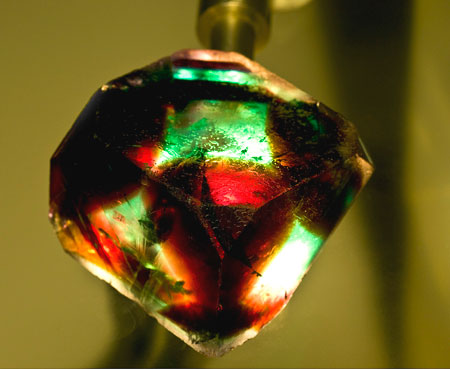 |
| Fluorite cube with phantoms, 6.0 x 6.0 x 4.5 cm. Price available upon request. (Photo: Jason Stephenson) |
Second is an alien-like fluorite cube with spooky green and red banding, creating phantoms. A limited number of these fluorites were found in Erongo from the appropriately named “alien pocket.” The material is very dark and only comes to life with bright transmitted light. The photograph above shows the fiber-optic light converging underneath the fluorite to accentuate the color and mask-like patterns. Several new alien-fluorite pieces will be available for sale; call or email us to inquire.
Interested? Email us, or give us a call. [back to top]
October: Willemite & Hemimorphite, Mimetite, and Vanadinite
More from the Gabriel Risse Collection
This month we feature a couple more highlights from the recently acquired Gabriel Risse collection. These specimens reflect Risse’s keen appreciation of artistic form, rare composition, and striking contrasts of tone and hue.
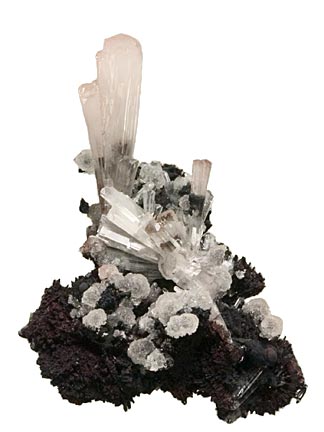 |
| Willemite and hemimorphite on matrix, 9.3 x 6.5 x 3 cm. Inventory #16774. |
The first specimen is an unusual combination of willemite and hemimorphite on matrix. This specimen comes to us from the Potosí Mine near Santa Eulalia in the state of Chihuahua, Mexico. The hemimorphite’s long, slender prismatic crystals contrast in form to the botryoidal crystals of the willemite with their druzy-like surface. A true sculpture by Mother Earth featuring dark earthy tones of black and brown mixed with lustrous white crystals with just a touch of pink.
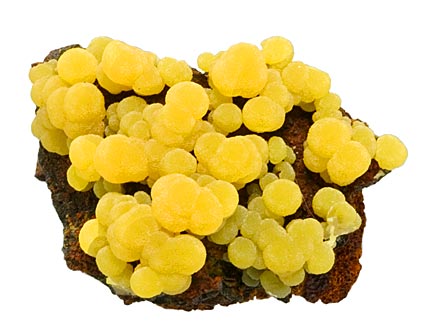 |
| Mimetite on matrix 4.7 x 3.5 x 2.8 cm. This specimen has been sold. |
The second specimen jumps out at you with bright yellow botryoidal mimetite crystals splashed on brown limonite matrix. This mimetite was found in San Pedro Corralitos, in the state of Chihuahua, Mexico. The separation of the mimetite allows the matrix to create a nice contrast, defining the robust form of the mimetite crystals.
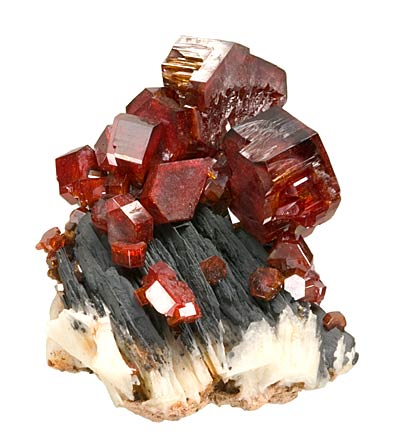 |
| Vanadinite on matrix, 4.3 x 4 x 4.6 cm. Inventory #16780. |
The third featured item is a very aesthetic specimen with large vanadinite crystals perched on top of a barite matrix. This specimen is from the ACF mine in Mibladen, Morocco. The tabular vanadinite crystals range from 20 mm. to 2 mm., with larger ones taking on some etched and hoppered faces. The vanadinite clusters are sprinkled on top of crested parallel blades of charcoal gray barite with a white base.
Stay tuned for more from the Risse collection or call in inquire about what’s still available.
Interested? Email us or give us a call. [back to top]
August: Pyromorphite, Tourmaline on Quartz, and Rhodochrosite
Culled from the Gabriel Risse Collection
This month we feature three new specimens from the new Gabriel Risse collection acquired by the Larson boys at this year’s Sainte-Marie-aux-Mines show in France.
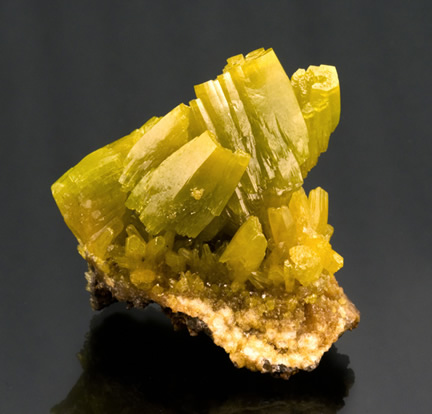 |
| Pyromorphite specimen, 3.9 x 3.4 x 2.5 cm. This specimen has been sold. (Photo: Wimon Manorotkul) |
The first piece is a superb miniature pyromorphite specimen from the Bunker Hill Mine in Kellogg, Idaho. Classic rounded barrel hopper crystals with cavernous centers. Vivid greenish yellow color with one main crystal surrounded by various size intersecting crystals. This is a specimen you just keep spinning in your hand to see all the great angles and details.
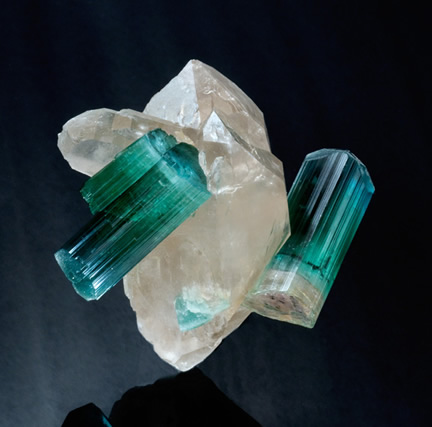 |
| Tourmaline on quartz specimen, 6.5 x 6.5 x 3.5 cm. This specimen has been sold. (Photo: Wimon Manorotkul) |
The second piece is a completely unique tourmaline on quartz from Paprok, Afghanistan. The two tourmaline crystals are so gemmy, with a neon greenish-blue hue, that it would make any cutter drool with temptation. One crystal is doubly terminated with a subtle gradation from bluish green to greenish blue with a frosted pyramidal cap. The other crystal is thicker with a cleaved pink-and-white bottom and an upper half that is virtually flawless. If that weren’t enough, the two beautiful tourmalines are naturally attached to a doubly terminated quartz crystal.
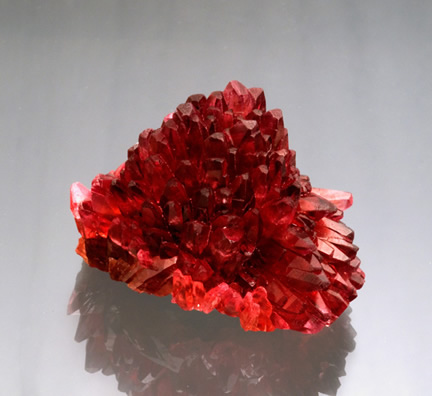 |
| Rhodochrosite specimen, 4.1 x 3.1 x 2.8 cm. This specimen has been sold. (Photo: Wimon Manorotkul) |
The third specimen is an exquisite rhodochrosite from N’Chwaning, South Africa. Reminiscent of “The Snail,” this miniature is a radiating cluster of individual scalenohedron rhodochrosite crystals. The specimen glows from the heart with an intense red hue when backlit, almost revealing its near-flawless interior. [back to top]
June: Minerals of the Andes
Vivianite and Rhodochrosite
This month we feature some exceptional specimens from the central Andes Mountains in South America. The two mining regions highlighted are very remote and are found above 10,000 feet.
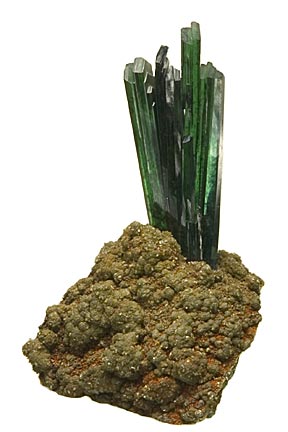 |
| Vivianite specimen, 10 x 6.6 x 5.5 cm. This specimen has been sold. |
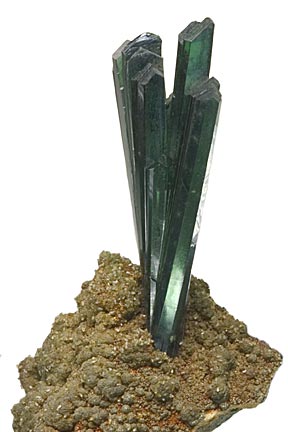 |
First, we have a striking cluster of vivianite crystals on matrix from the Potosí mining district in Bolivia. The long and slender acicular dark crystals form a small fan-like arrangement. Transmitted light reveals an intense evergreen hue in these clean, sharp crystals. The vivianite crystals lie on a botryoidal limonite matrix, and when the specimen is flipped over, a solid iron-pyrite core is revealed.The specimen comes from the Potosí deposit, which was one of the original sources for vivianite in Bolivia. Production from this deposit is very limited today, while most of the vivianite comes from other mines within the region. For more on vivianite, see Mindat.org.
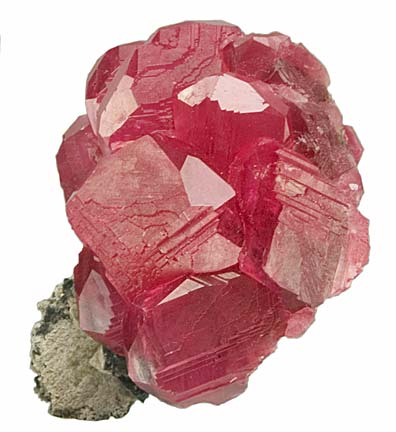 |
| Rhodocrosite specimen, 4.8 x 4.2 x 3.1 cm. Inventory #16371. |
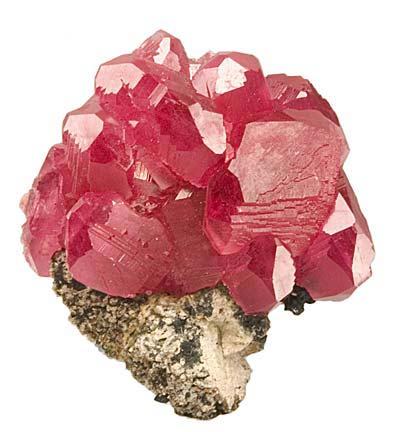 |
Our second featured mineral comes to us from the Pasto Bueno mining district in Peru. This rhodochrosite ball consists of intertwined scalenohedron crystals in a radiating-type fashion. This unusual golf ball-sized formation exhibits sharp, undamaged edges, lustrous faces, and some etched sections. This beautiful cluster of intensely-colored crystals glows with a neon pinkish-red hue, with transmitted light. The Pasto Bueno district is in the Pallasca province of Peru and actually includes seven different mines. Matching rhodochrosite specimens to the exact mine is a difficult task because of the array of crystal formations. Rhombohedral formation is the most common in this region, which makes this rhodochrosite specimen very unique. For more on rhodochrosite, see Mindat.org.
Interested? Select the inventory numbers above, email us, or give us a call. [back to top]
April: Amethyst
Amethyst is not just a pretty little faceted purple stone you see spinning around on the television gem shows. It actually has a quite unique array of crystal forms that are found on several continents. From Brazil and Uruguay, to India and Siberia, and even here in the U.S. from the state of Georgia. This month we feature two completely different forms of amethyst.
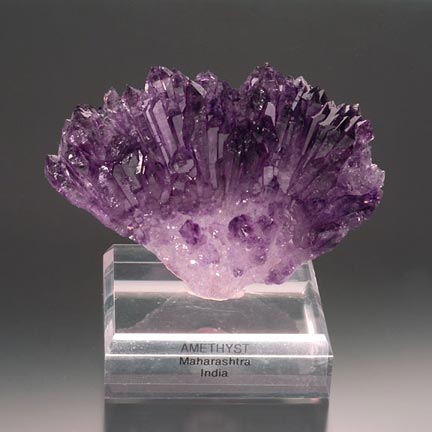 |
| Amethyst spray cluster, 11 x 8 x 2 cm. This specimen has been sold. (Photo: Wimon Manorotkul) |
This amethyst, from Maharashtra, India has an unusual radiating pattern that sprays out from the center to individual terminations. Slender amethyst crystals, like tightly packed rays of the sun, fan out in a beautiful arrangement. Pleasing to the eye and easy on the checkbook.
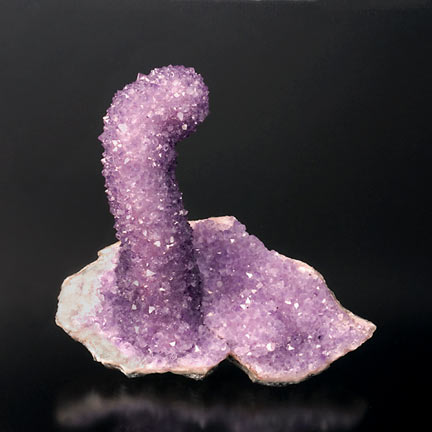 |
| Amethyst worm specimen, 11.5 x 11.5 x 5.4 cm. Inventory #16265. (Photo: Wimon Manorotkul) |
The second amethyst crystal comes to us from Artigas, Uruguay. This peculiar specimen features an overgrown druzy column that seems to be growing out of a geode-like base. Tiny amethyst crystals, densely packed, cover what was probably the inside of a vug. Then gravity or some internal force pushed a cylinder of amethyst melt into this worm-like form, ultimately being left to cool properly and giving rise to the network of sharp amethyst crystals.
Amethyst, in its many forms and memorable purple hue, is an obtainable mineral for the novice collector, but also very desirable for the veteran collector in search of the amethyst oddity.
Interested? Email us, or give us a call. [back to top]
February: Pink Tourmaline and Diopside
This time we couldn’t help but feature two minerals—one to stay on topic with this year’s Tucson theme of Minerals of the USA, and another to show off our new glowing neon-green crystal from Tanzania.
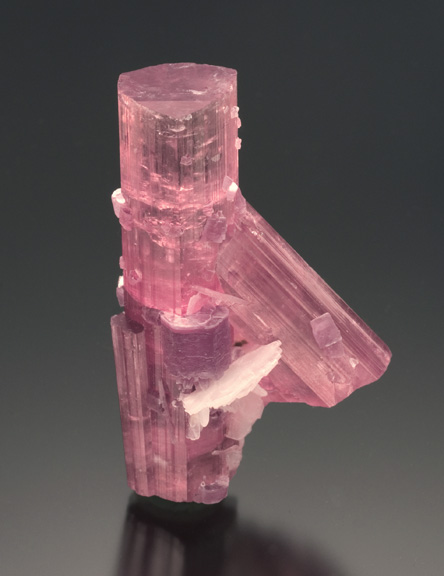 |
| Pink tourmaline. The larger crystal measures 6.2 x 2.5 cm.; the smaller crystal measures 3.3 cm. Price available upon request. (Photo: Wimon Manorotkul) |
This beautifully crystalline and glassy pink tourmaline specimen was dug by Pala International during our 20-year mining efforts at the Himalaya mine here in San Diego County. The mine produced all shapes, sizes, and colors of tourmalines, but this one seems to have some extra intrinsic beauty. It’s composed of two interlocking pink transparent crystals of tourmaline with some lepidolite sprinkled on top. One exceptional 9-mm. lavender lepidolite crystal is positioned right at the tourmaline junction and sits on a plate of white clevelandite.
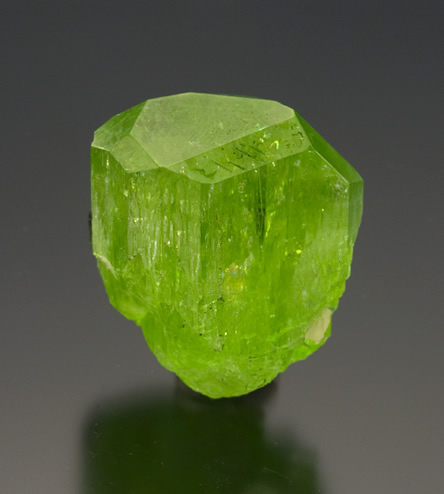 |
| Diopside from Tanzania. This specimen measures 3 x 2.5 x 2.5 cm. This specimen has been sold. (Photo: Wimon Manorotkul) |
This shocking diopside crystal seems to take on a neon glow of yellowish green. The crystal is a bit beat-up on the bottom but shows a short shiny shaft and is topped off by a glassy complex termination with windows into the heart of the gem. This diopside crystal is from the Arusha region of Tanzania where the massive tanzanite deposits lay. In rare cases tanzanite and diopside can be found on the same specimen as exhibited by Inventory #16009. [back to top]
2007
Featured in Pala’s Mineral News. All photographs by John McLean unless otherwise noted.
December: Dioptase and Quartz
This time we feature an exquisite dioptase and quartz specimen from the Tsumeb mine in Namibia. A delightfully sparkly piece with a larger version of drusy quartz coating the surface; individual crystals measuring about 3 to 4 mm. The little quartz crystals overlay a thin layer of dioptase, which can be seen from the back.
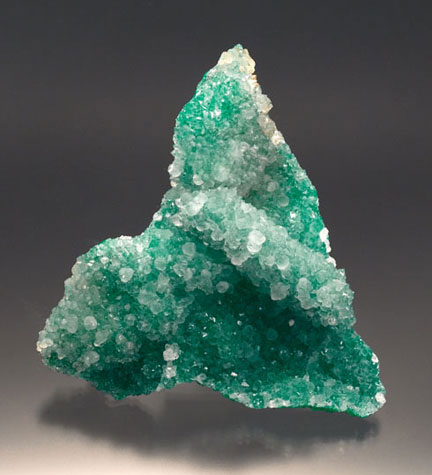 |
| Lights on out front, showing the character of the quartz crystals. Specimen is 11 x 8 x 0.6 cm. Price upon request. (Photo: Wimon Manorotkul) |
At first glance the clear quartz crystals seem to have a soft green background, but when you use transmitted light the piece glows vivid green. The dioptase-laden back side brings out a different character when backlit, as seen below. The morphology of the underside seems to be a cast of some sort, creating the undulating surface.
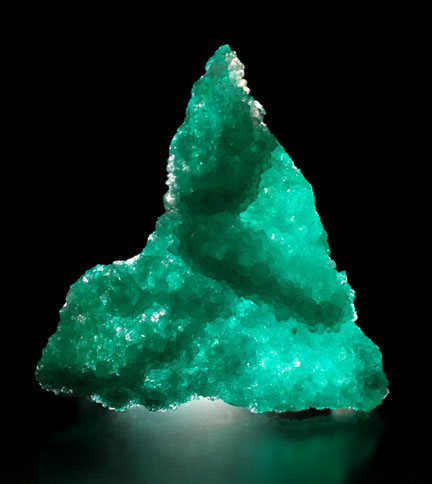 |
| Lights on from the back, showing the neon green of the dioptase layer. Specimen is 11 x 8 x 0.6 cm. Price upon request. (Photo: Wimon Manorotkul) |
Interested? Email us, or give us a call. [back to top]
October: Malachite Pseudomorph
In this edition of Mineral News we feature a velvety malachite after azurite specimen with a big bladey crystal and intricate secondary clusters. This material has reportedly been pulled out of the ground in the last year. This piece is said to be one of the best specimens from the new discovery in Chihuahua, Mexico.
The quality of the new find has been compared to the material found in Arizona, from the Tiger Mine, and Namibia from the Tsumeb Mine. The true classification of this deposit is still being qualified amongst the great finds in Arizona and Namibia, but the specimens are definitely a refreshing sight. The malachite takes on a velvet luster and has a sheen that moves like a chatoyant gem.
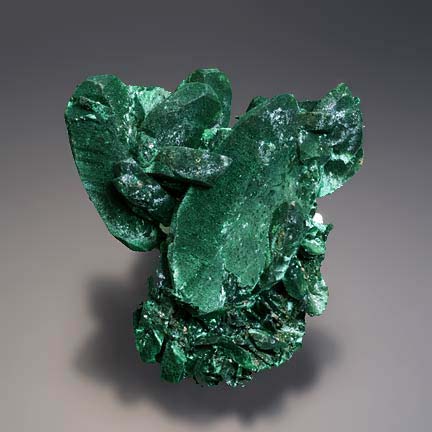 |
| Malachite pseudo after azurite, 8.3 x 7.6 x 2.8 cm. This specimen has been sold. (Photo: Wimon Manorotkul) |
This new find of malachite pseudomorphs from Mexico seemed to be the only new find that was producing any noteworthy specimens at the show last month in Denver.
Visit our mineral search for a selection of malachites from around the world. [back to top]
August: Azurite
In this edition of Mineral News we feature an azurite cluster on matrix.
This dramatic specimen consists of four interlocking azurite crystals atop a dark black and green host. The azurite crystals are well formed blades with nice glassy terminations and sleek striated sides. The crystals have a blotchy dark blue-to-greenish blue exterior, with some electric blue translucency. The largest azurite crystal measures 33 x 20 x 9 mm.
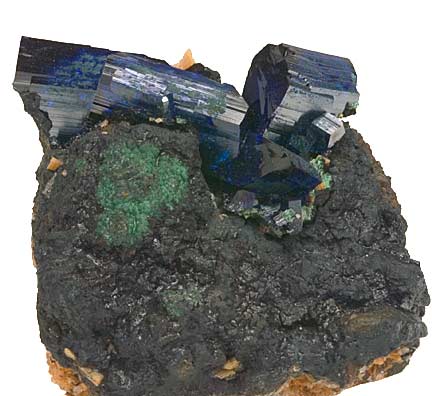 |
| Azurite specimen, 6.7 x 5.8 x 5.6 cm. This specimen has been sold. |
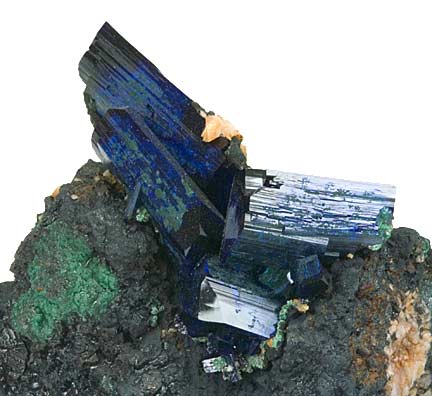 |
This azurite specimen was collected in the Touissit Mine, south of Oujda, in eastern Morocco. This piece was originally part of Dr. Eric Asselborn’s collection. [back to top]
June: Epidote
This month we feature a slender and exquisite epidote crystal from the historic Knappenwand Mine in Austria.
This epidote appears jet black and lustrous at first glance, but upon further examination evergreen hues start to shine through the translucent portions. This dark and intense specimen is in pristine form and is said to be the finest of its kind in private hands. Price upon request.
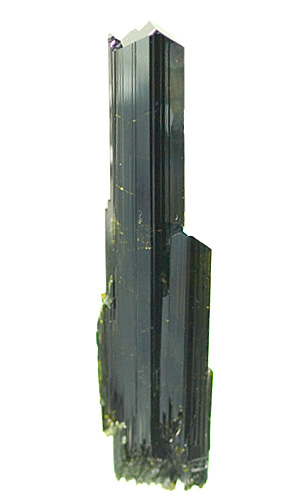 |
| Epidote Crystal, 11.8 x 2.8 x 1.2 cm. This specimen has been sold. |
The Knappenwand Mine near Neukirchen am Grossvenediger, in the state of Salzburg, Austria, is situated in the remote Tauern Alps. This locality was discovered by a mountain guide in 1865. The epidote specimens were described as the “most beautiful epidote crystals ever found” by Professor Victor Ritter Von Zepharovich of Charles University in Prague (Bancroft 1984). This epidote was reportedly mined in the late 1800s and has been carefully handed down through generations of mineral collectors. The original label has even been preserved (see below).
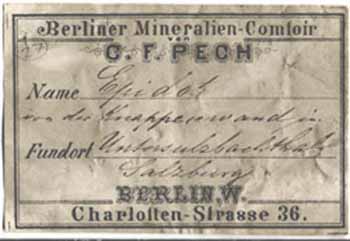 |
| Epidote label. Preserved mineral label circa late 1800s from Berliner Mineralien-Comtoir. |
Visit our mineral search for a selection of epidotes from around the world. [back to top]
April: Alexandrite
In April we feature an alexandrite sixling from the Griddlestone Claim in Zimbabwe.
The alexandrite specimen has a striking appearance with one well-formed sixling on one side and a partial larger spray on the other side. This dark and intense specimen even shows a good color change. The arms of the sixlings seem to penetrate throughout the entire specimen in etched terraces. Price upon request.
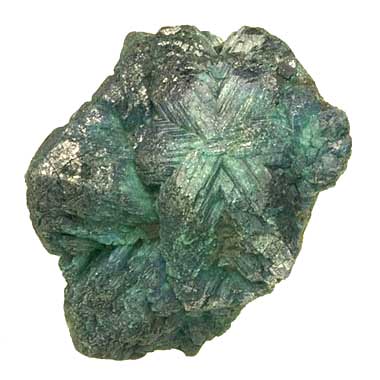 |
| Alexandrite specimen, 111.8 grams, 50.0 x 48 x 34 mm. This specimen has been sold. |
Visit our mineral search for a selection of alexandrites from around the world. [back to top]
February: The Mogok Castle
In February we feature a natural ruby crystal from Mogok, Burma.
The specimen is well formed and doubly terminated. This complex specimen has six well-formed sides with angular etching running throughout. This intense ruby is also intertwined with white calcite, which makes for a stark contrast with the deep red hue. Topping off this exquisite ruby castle, we find a shiny turret extending out from the main structure. Price upon request. See it for yourself in Tucson.
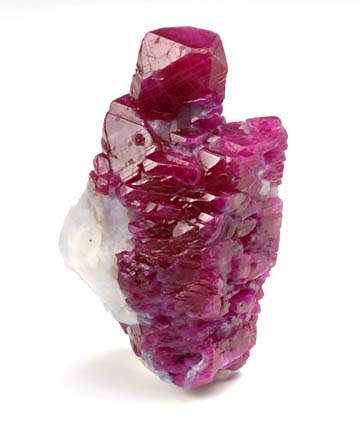 |
| The Mogok Castle, 81.2 grams, 56.0 x 26.5 x 23.8 mm. Seeing it for yourself... priceless. This specimen has been sold. (Photo: Wimon Manorotkul) |
The following passage has materialized through myth, from the Land of the Rubies.
Burmese Ruby Crystal... A glimpse of pigeon’s blood colour.
The Bedin-saya, who interpret dreams in shaded, scented corners of the markets, tell of Burmese ruby as different from Rubies in the rest of the world. One only needs to look to see, they say. Burma Ruby challenges credibility. Nature could not permit such a condensation of colour creating absolute Red; without theft and vacuum in the remainder of the world.... The true pigeon’s blood is more a colour of the mind than the material world. “Asking to see the pigeon’s blood is like asking to see the face of God.”
Read more on ruby here. [back to top]
More for February: Red Beryl is Back
Gem-quality red beryl is really only found in the Wah Wah Mountains of southeast Utah. This variety of beryl is associated with a white volcanic rhyolite. The combination of red and white makes for some spectacular mineral specimens. To illustrate the rarity of fine quality specimens, it was reported that the Utah deposit yielded 0.5 ct. of facetable red beryl for every 1 ton of rock removed (Rex Harris 1976–1994). It was calculated elsewhere that every 1 ton of rock would yield 0.25 grams (1.25 ct.) of rough gem grade red beryl, of which 90% was lost in cutting, leaving a 0.125-ct. faceted gem (KEC 1996). To learn more on red beryl see Gems & Gemology (39:4, Winter 2003).
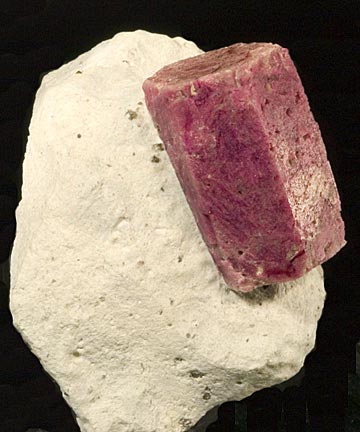 |
| Red beryl well formed doubly terminated crystal on rhyolite matrix. Opaque crystal with strawberries-and-cream type appearance. Dimensions: 30 x 19 mm. This specimen has been sold. |
New at Pala. These two beauties were plucked from the top of the barrel, having the best and biggest crystals. The barrel does run pretty deep, however, so there are specimens ranging in all shapes, sizes, and quality; something for every level of collector.
The future mining of red beryl is uncertain, so this may be a good opportunity to acquire this endangered species.
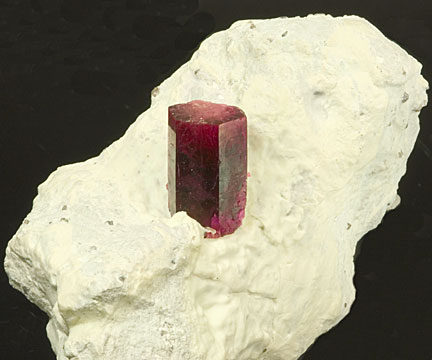 |
| Fine red beryl. This crystal is in excellent condition, with perfect hexagonal shape, translucent gemmy portions, and an intense cherry-red hue. Dimensions: 18 x 11 mm. This specimen has been sold. |
[back to top]
2006
Featured in Pala’s Mineral News. All photographs by John McLean unless otherwise noted.
December: Zoisite
In month we feature natural yellow zoisite from the Merelani Hills of Tanzania.
The first is a well formed crystal with an excellent multi-faced termination. The overall shape of the crystal follows suit for tanzanite, yet the color is quite unusual for zoisite, with hints of of green and gold shining through different axes. A great specimen to complement any tanzanite collection showing the unusual colors of zoisite.
 |
| Yellow zoisite, Merelani, Tanzania, weight 79.48 cts., dimensions 2.8 x 2.3 x 1.3 cm. This specimen has been sold. (Photo: Wimon Manorotkul) |
Our second featured item is a rough and cut yellow zoisite pair. This interesting pair shows another side of zoisite. The rough piece has a nice euhedral shape, excellent termination, and the upper third of the crystal is very gemmy, making it a superb specimen. The faceted gem is a pleasing cushion shape showing blends of yellow and green. The couple is well priced for $6,400.
 |
| Rough and cut yellow zoisite from Merelani, Tanzania. Rough weighs 24.38 cts., dimensions 2.8 x 0.85 x 0.75 cm.; cut gem weighs 9.47 cts., dimensions 13.5 x 10.7 x 7.6 mm. These items have been sold. |
[back to top]
October: Malachite and Fluorite
In October we feature two small, exquisite cabinet specimens.
The first is a classic old Tsumeb pseudomorph of malachite replacing azurite. This is an exciting piece; as can be seen, the view angle is good from either side. The specimen was exchanged from the Gene Meirans collection. Mounted on a custom Sunnywood lucite base, it is a fine show-quality piece for the advanced collector. Price: $5,500.
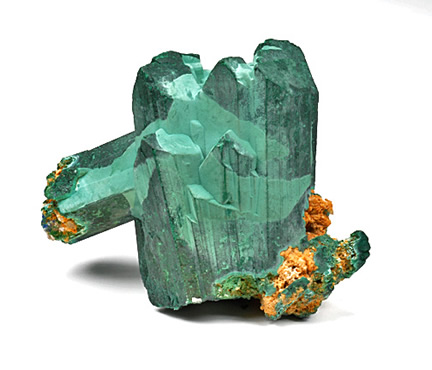 |
| Malachite after azurite from Tsumeb, Namibia, 7 x 5 cm. This specimen has been sold. (Photos: Wimon Manorotkul) |
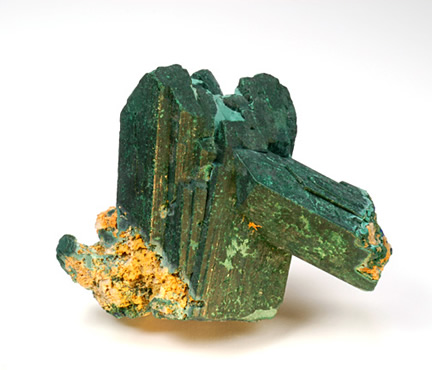 |
Our second featured piece is a vivid Moroccan fluorite on barite. This wonderful, bright, unusually colored specimen is very different from most Moroccan fluorites we have seen. Mined in 2004, it comes from the Taourirt Mine (near Taourirt, 108 km. south of Oujda, in the Oriental Region). It is very well priced at $400.
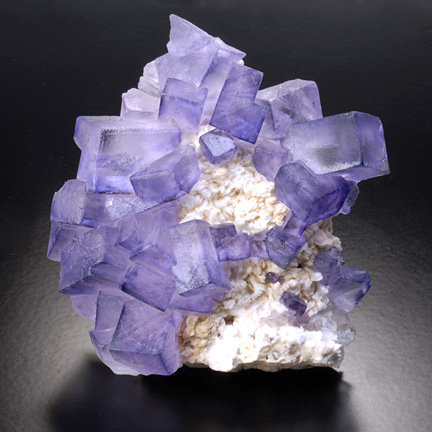 |
| Fluorite on barite from Taourirt, Morocco, 8 x 7.4 cm.; the largest cube is 1.8 x 1.3 x 1.5 cm. This specimen has been sold. (Photo: Wimon Manorotkul) |
[back to top]
August: Kunzite and Aquamarine
We’re excited to offer a single kunzite crystal along with a pair of aquamarines (priced separately).
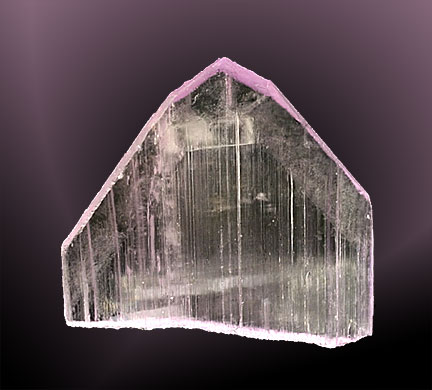 |
| Kunzite crystal from Paprock Afghanistan, 12.2 x 10.7 x 1.3 cm. Inventory #13795. |
This is a classic-form kunzite (above), from Paprock, Afghanistan. It is a complete, wonderful single crystal with no damage. Even the base is complexly terminated. The color is fine pink-purple down the “C” axis. Note the extra-sharp faces at the top of the crystal. An excellent cabinet specimen. Price: $2,800.
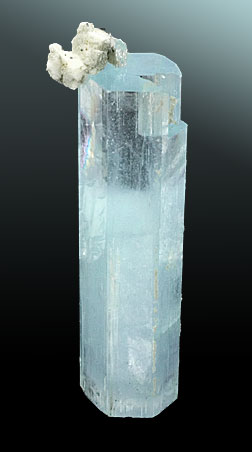 |
| Double-terminated aquamarine crystal with feldspar orthoclase, 8.6 x 2.4 x 2.2 cm. |
Above, an aquamarine from Shigar Valley, Pakistan. A beautiful and perfect specimen, with good color and proportions, doubly terminated. Brought to us in Sainte-Marie-aux-Mines directly from Pakistan by a good friend of Pala International. Price: $2,400.
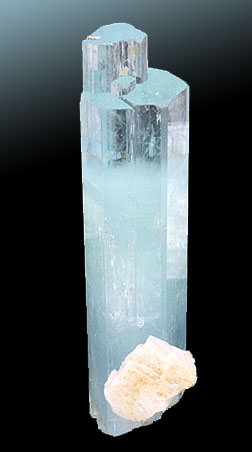 |
| Double-terminated aquamarine crystal with feldspar orthoclase, 9.9 x 2.3 x 2.1 cm. |
A second aquamarine from Shigar Valley, Pakistan. As with the above specimen, this is an exquisite, undamaged, doubly terminated specimen, delivered to us in Sainte-Marie from Pakistan by our friend. Bill Larson: “I love the termination complexity with the single rising above the base termination by a centimeter or so.” Price: $2,400.